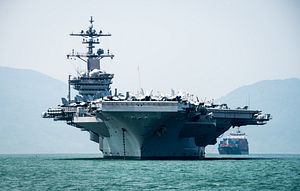Last week, the U.S. aircraft carrier Carl Vinson pulled into Vietnam’s port of Danang, the first visit by a U.S. aircraft carrier since the end of the two countries’ conflict in 1975. The historic visit is a milestone in deepening military ties between the former adversaries as China works to solidify its claims and authority in the South China Sea. While China tried alternately to downplay or dismiss the visit, it must contend with a rising tide of external engagement and balancing in the region motivated by unease over its long-term intentions.
An editorial in the Global Times, a tabloid published by China’s official People’s Daily newspaper, sought to dismiss the visit, claiming that the Vinson’s visit couldn’t “stir up troubles” in the South China Sea and insisting that enhanced military exchanges between the two former adversaries won’t produce any “special tools” to direct against China.
Another editorial from the South China Morning Post dismissed the United States’ pursuit of a security relationship with Vietnam entirely, calling it a flawed strategy that creates unnecessary tensions by “promoting threats that do not exist.”
The overt dismissiveness in both articles instead suggests acute Chinese anxiety over regional cooperation and the increasing presence of extra-regional navies in the South China Sea.
Meanwhile, China’s Ministry of Foreign affairs tried to downplay the Carl Vinson’s visit, saying that “We have no problem with relevant countries developing normal relations and conducting normal cooperation,” and merely cautioning that it hoped that cooperation supported regional peace and stability. But China’s Foreign Minister, Wang Yi, implied to reporters during the National People’s Congress in Beijing last week that the Vinson’s visit was “the greatest disturbance to the peace and stability in the South China Sea” and that external countries – meaning principally the United States – wanted to “stir up trouble” in the region.
By hosting the carrier, Vietnam communicated that “peace and stability” in the region isn’t China’s alone to define to its own advantage. While the port visit is largely symbolic, the two countries’ burgeoning military relationship is increasingly concrete, though experts are quick to point out that Vietnam’s diplomatic “three no’s” (no foreign bases, no alliances, no third-party involvement) mean it is unlikely to enter into a formal alliance or partnership with the United States. Nevertheless, U.S. warships began conducting voyage repairs in Cam Ranh Bay, a critical logistics hub for the United States during the Vietnam war, in 2016, and U.S. Secretary of Defense James Mattis’ official visit this past January augurs even more exchanges and cooperation in the future.
Nor does the United States believe Vietnam is alone in its unease with China’s expanded activity in the region. While the USS Carl Vinson was in-port at Danang, the commander of the Japan-based U.S. Seventh Fleet, Vice Admiral Phillip Sawyer spoke to reporters about how it was uncertainty about China’s intentions in the region that was the primary driver of potential instability. “It’s not quite clear what’s going to happen down there [in China’s South China Sea bases], and I think that angst and that lack of transparency is potentially disruptive to the security and stability of the region. And that causes concern.”
The United States’ response to that concern has been to maintain a robust presence in the South China Sea so far in 2018. It apparently conducted a Freedom of Navigation Operation in the vicinity of the Chinese-claimed Scarborough Shoal in January, where an international arbitration court ruled that China had no historical rights and had violated the Philippines’ rights within its own Exclusive Economic Zone. In the broader western Pacific, the first squadron of U.S. Marine Corps F-35B aircraft have deployed on the USS Wasp. The Commandant of the Marine Corps, General Robert Neller, says integrating the advanced fighter into the fleet is part of the Marines’ contribution to establishing sea control for U.S. forces, and denying it to adversaries.
And increasingly, the United States is not alone. Following its historic port visit in Danang, the Carl Vinson began conducting advanced anti-submarine and air-defense exercises in the South China Sea with one of Japan’s largest warships. Both Japan and France has been cultivating closer military ties and cooperation with the Philippines. Australia is increasing its naval presence in the region out of concern over China’s intentions. This week a British frigate will patrol the South China Sea and Foreign Secretary Boris Johnson has pledged that the first deployment of Britain’s new supercarrier, the HMS Queen Elizabeth, will include patrols in the region.
China can continue to insist that it is committed to peace and stability in the South China Sea, but few countries appear willing to accept its assurances.

































